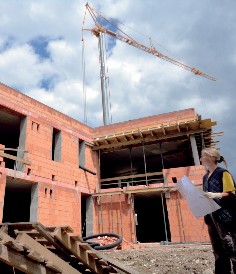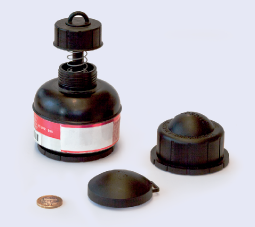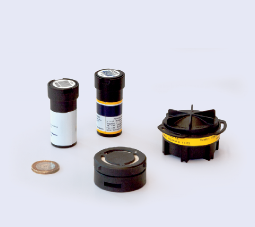Radon - measurement and evaluation Eigenschaften, Vorkommen und Wirkung von Radon
Properties and occurrence
Radon is a naturally occurring radioactive noble gas that is colorless, odorless and tasteless. It is a decay product of the radioactive heavy metal uranium found in soils and rocks. Radon escapes from soils and rocks into the soil air. With the soil air, it can enter the indoor air of buildings.
An initial indication of whether elevated radon concentrations can be expected in the indoor air of buildings can be obtained from the national radon maps. Only a measurement can give certainty about the radon concentration in the respective building.
Detailed information on radon can be found on the country-specific websites. These addresses are listed on the back of this brochure.
Note: National specifications or recommendations may differ from the present contents!
Annual mean radon concentrations normally range from 50 to 500 becquerels per cubic meter of air. However, values up to several 1,000 Bq/m³ can also be reached - especially in radon areas.

Effect on health
After smoking (about 85%), radon and its decay products are a leading cause (5 to 10%) of lung cancer. In people who have never smoked, radon is the most common cause of this type of cancer. Radon and smoking reinforce each other in their harmful effects on human health. Most of the radon inhaled through the air is exhaled again. The greatest health risk is therefore not posed by the radioactive noble gas radon itself, but by its short-lived decay products (radioactive heavy metals).
The free decay products present in the indoor air attach themselves to airborne suspended particles (aerosols). When breathing, the aerosols with the attached radon decay products are deposited in the lungs. From there, they emit ionizing radiation that can damage the immediately surrounding lung tissue and ultimately cause lung cancer.
Reference values and threshold values
The following table shows the current reference values and thresholds for annual mean radon concentrations in homes or workplaces of the different countries.
Country/Region | Reference values for existing buildings | Reference values for new buildings | Threshold values |
Germany | 300 Bq/m3 | 300 Bq/m3 | - |
| Austria | 300 Bq/m3 | 300 Bq/m3 | - |
| Switzerland | 300 Bq/m3 | 300 Bq/m3 | *1,000 Bq/m3 |
| South Tyrol | 300 Bq/m3 | **200 Bq/m3 | - |
* for workplaces
** for living quarters as of 31.12.2024

Composition of the subsoil
In addition to the composition of soil and rock (uranium, radium content), the grain size of the rock (release of radon to the soil air) and the permeability of the subsoil (onward transport of the radon-containing soil air) play an important role. Special caution is required for rubble cones and slopes, weathered granite, karst and gravel soils (high radon availability due to good permeability) - in contrast to very compact or clayey soils.

Building condition
The permeability of a building to soil air in the foundation area as well as in walls in contact with the ground is decisive. Possibilities of penetration exist, for example, through cracks and crevices as well as along cable and pipe penetrations. The radon-containing soil air is sucked into the building by a negative pressure created in the building (chimney effect due to temperature differences between room and outside air or due to wind pressure). If cellars or other building areas with ground contact are open to floors above, radon can spread upwards particularly easily.

Air exchange in the building
The exchange between indoor air and outdoor air has a significant influence on the level of indoor radon concentration. Leaky windows and doors lead to higher air exchange rates. If, on the other hand, the air exchange rate is reduced, for example by installing tightly closing windows and doors, the radon concentration in indoor spaces can increase considerably.
When are radon measurements required?
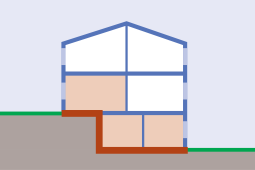

Living spaces with ground contact
The radon concentration in indoor spaces can be easily determined with special measuring instruments.
Studies have shown that the annual mean radon concentration of a building is very strongly dependent on the construction method (e.g. foundation design, basement, building tightness) and the user behavior (e.g. ventilation habits). Therefore, neighboring buildings often have very different radon concentrations.
You can only be certain of the radon concentration in your building by taking measurements. For this reason, radon measurements are recommended in buildings where occupied rooms (living rooms and workplaces) are in contact with the ground (for example, on a slope, no basement or an occupied basement) or in buildings in areas with an increased radon risk.
If renovation work on floors and walls is planned in living spaces or workplaces with ground contact, for example energetic (thermal) renovations or additions, radon protection measures can be planned and implemented much more cost-effectively and effectively than in retrospect. Therefore, measurement is recommended in these cases.
Knowledge of the radon concentration is also desirable when buying a property.
Variation of radon concentration in residential buildings
Radon concentration in buildings usually shows strong temporal and spatial variations (see graph). There are diurnal and seasonal fluctuations, depending on the weather. These are mainly caused by the chimney effect in the house, i.e. when there are temperature differences between indoor and outdoor air.
These fluctuations are exacerbated by occupant behavior (ventilation, heating, etc.). In addition, differences in room use, distribution of radon entry points, and air exchange provide for different levels of concentration in rooms. As a rule, radon concentration decreases on higher floors.
Measurements for reference value comparisons
Indoor measurements for reference value comparisons can be carried out easily, reliably and cost-effectively by recognized bodies.
Reference values and - if available - threshold values are given as annual mean values for occupied rooms under normal use (see table on page 3). It is recommended to carry out a measurement over an entire year in at least two occupied rooms. Please observe the national specifications for carrying out radon measurements for the comparison of reference values in residential buildings and workplaces!
In residential units that are not used or only occasionally used (for example, in weekend houses), standard measurements for reference value comparisons are not useful. If necessary, measurements adapted to individual conditions can be carried out in consultation with a radon specialist or a recognized body.
Carrying out the measurement
Measurements are usually performed with simple passive measuring devices. These measuring devices are small, handy and can be sent by mail. The handling of the measuring devices (detectors) is simple, they do not emit radiation and are non-toxic.
For the installation of the measuring device in the room, a free place should be chosen, which is
- is far from doors and windows and free from drafts,
- is not directly against the wall (at least 10 cm distance),
- is not strongly heated (for example by direct sunlight or heating),
- is inaccessible to children and pets, and
- does not have condensing moisture.
Measurements for remediation planning and verification
If radon remediation is to be carried out, it is expedient to determine the time course of the radon concentration for its planning. Measurements in which several measuring devices are in use at the same time in different rooms provide the best information. However, it is also possible to measure several rooms one after the other with a single measuring device. In this way, entry points and propagation paths of radon can be better delimited, and the effects of user behavior or the effectiveness of provisional measures can be better estimated.
Time-resolved measurements are also used to directly check the effectiveness of remediation measures. The execution of the measurements as well as the evaluation of the results require some experience. Information can be obtained from the websites of some of the institutions listed on the back cover of this brochure.
After completion of the remediation, a measurement for reference value comparisons (see page 7) is to be carried out by a recognized body. Such a measurement should be repeated at regular intervals.
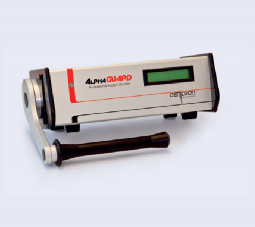
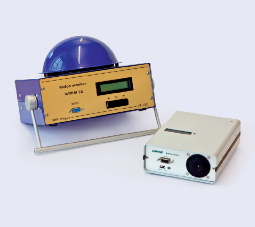
Orienting measurements
An orientational measurement is a quick procedure that is used when time is of the essence - for example, when a property is sold or when renovations are imminent. It is primarily used to estimate the possible radon concentration of a residential building. The planning of the measurement and the evaluation of the measurement results must be carried out by a radon specialist.
Since it is difficult to draw conclusions about the annual mean value from orienting measurements, it is recommended to carry out a measurement for reference value comparisons (see page 7) if possible.
Recommended measurement method
The measurement is time-resolved over a period of one week:
- six days in different occupied rooms (e.g. bedrooms, children's rooms, living rooms and other common rooms), preferably with ground contact; measurement duration per room at least one day
- one additional day in a non-occupied room, if available, with earth contact and the highest radon concentration to be expected (technical room, earth cellar, laundry room, etc., if not available in the bathroom of the lowest floor).
Since the radon concentration is significantly influenced by the occupant's behavior (ventilation) and the weather, the following should be done during orientation measurements
- air thoroughly before starting the measurement,
- ventilate as little as possible during the measurement,
- make sure that the interior doors are closed during the measurement, and
- the building should be occupied or at least heated.
Measurements of radon in soil air
In principle, it is also possible to determine the radon concentration in the soil air. It is mainly determined for the identification of radon risk areas and for scientific purposes.
For building practice, however, a soil air measurement is very time-consuming, cost-intensive and not meaningful.
Therefore, for new buildings, it is recommended to carry out precautionary measures in accordance with the national building regulations for radon without prior soil air measurement on the building ground.
